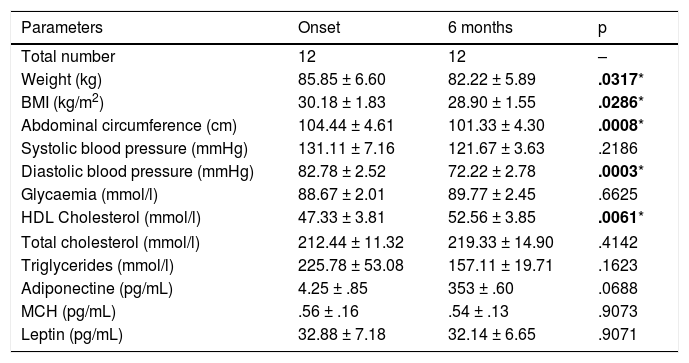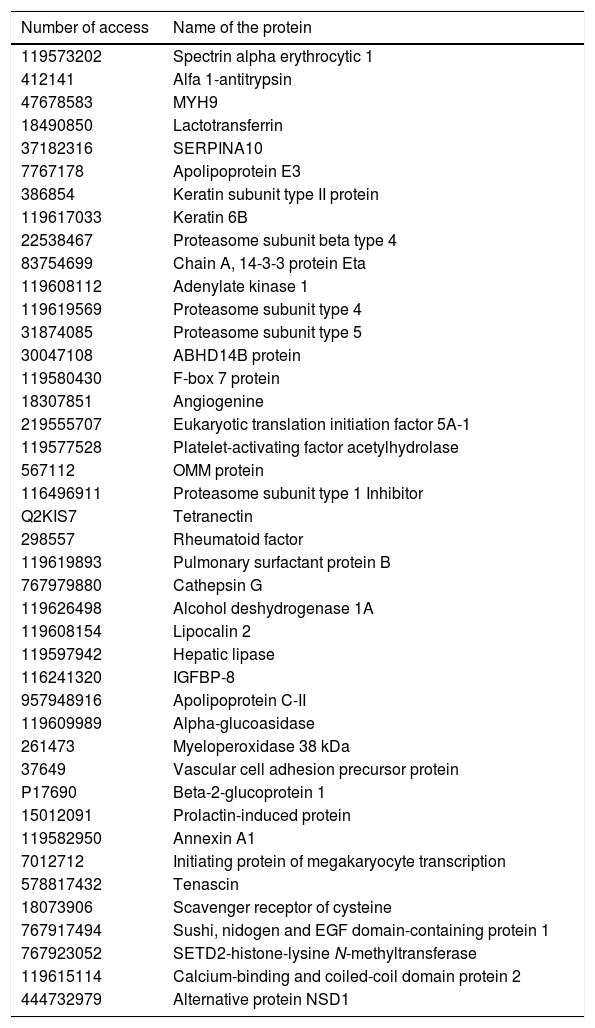Schizophrenia is a chronic illness often accompanied by metabolic disorders, diabetes, obesity and cardiovascular problems often associated with unhealthy lifestyles, as well as neuroendocrine problems caused by the disease itself. Lifestyle changes, such as regular physical exercise, have a positive effect on metabolic disorders and mental health, although the molecular changes that occur in this type of patient and how they explain the changes in their response are unknown. This study wants to analyze in a novel way the proteins and molecular pathways involved in critical plasmatic proteins in plasma to reveal the pathways involved in the implementation of physical exercise and the changes that occur among patients who participate in such programs with those who leave.
MethodsTwenty-one patients with chronic schizophrenia underwent a daily, 6-month aerobic training program. We divided them into a group that completed the program (12 patients) and a second group that left the training program (9 patients). The biochemical and clinical data of each patient were analyzed and the proteomic profile of the plasma was studied using ESI-LC–MS/MS.
ResultsProteomic analysis recognizes 21.165 proteins and peptides in each patient, of which we identified 1.812 proteins that varied between both groups linked to the metabolic and biological regulation pathways. After clinical analysis of each patient we found significant differences in weight, BMI, abdominal perimeter, diastolic blood pressure, and HDL cholesterol levels. The main change that vertebrates both groups is the Self-Assessment Anhedonia Scale, where we detected higher levels in the dropout group (no physical activity) compared to the active group.
ConclusionThe benefits of physical exercise are clear in chronic patients with schizophrenia, as it substantially improves their BMI, as well as their clinical and biochemical parameters. However, our study reveals the biological and molecular pathways that affect physical exercise in schizophrenia, such as important metabolic proteins such as ApoE and ApoC, proteins involved in neuronal regulation such as tenascin and neurotrophins, neuroinflammatory regulatory pathways such as lipocalin-2 and protein 14-3-3, as well as cytoskeleton proteins of cells such as spectrins and annexines. Understanding these molecular mechanisms opens the door to future therapies in the chronicity of schizophrenia.
La esquizofrenia es una enfermedad crónica que suele ir acompañada de trastornos metabólicos como la diabetes, la obesidad y problemas cardiovasculares asociados muchas veces a estilos de vida poco saludables, así como a problemas neuroendocrinos ocasionados por la propia enfermedad. Los cambios en el estilo de vida, como la práctica de ejercicio físico regular, tienen un efecto positivo sobre los trastornos metabólicos y la salud mental. Sin embargo, se desconocen los cambios moleculares y su consecuente repercusión en los pacientes diagnosticados con esquizofrenia. Con este estudio se pretenden analizar los cambios moleculares inducidos por el ejercicio físico en pacientes crónicos con esquizofrenia.
MétodosVeintiún pacientes con esquizofrenia crónica fueron sometidos a un programa de entrenamiento aeróbico diario durante 6 meses. El grupo de pacientes se dividió en 2 subgrupos: un subgrupo que completó en su totalidad el programa de entrenamiento (12 pacientes) y un segundo subgrupo que abandonó el programa el primer día (9 pacientes). Se analizaron los datos bioquímicos y clínicos de cada paciente y se estudió el perfil proteómico del plasma mediante ESI-LC–MS/MS de tipo shotgun.
ResultadosEl análisis proteómico reconoció 21.165 proteínas y péptidos diferentes en el plasma de los pacientes. Concretamente, 4.657 proteínas sufrieron variaciones significativas, de las cuales fueron identificadas 1.812 proteínas relacionadas con las vías metabólicas y de regulación biológica. Tras el análisis de los parámetros clínicos en estos pacientes, se encontraron diferencias significativas en el peso, el IMC, el perímetro abdominal, la presión arterial diastólica y los niveles de colesterol HDL. La puntuación en la Escala de Autoevaluación de Anhedonia fue el cambio más significativo, siendo más elevada en el subgrupo que abandonó el programa de entrenamiento en comparación con el subgrupo activo.
ConclusiónLos beneficios del ejercicio físico son claros en pacientes crónicos con esquizofrenia, ya que mejoran sustancialmente su IMC, así como sus parámetros clínicos y bioquímicos. Además, este estudio desvela las vías biológicas y moleculares afectadas por el ejercicio físico en la esquizofrenia. A nivel molecular, se identificaron las proteínas ApoE y ApoC, que están implicadas en vías metabólicas; la tenascina y las neurotrofinas, asociadas a la regulación neuronal; la lipocalina 2 y la proteína 14-3-3, involucradas en las vías de regulación neuroinflamatorias, y las proteínas espectrinas y anexinas del citoesqueleto de las células. La comprensión de estos mecanismos moleculares abre la puerta al estudio de estas proteínas asociadas a la cronicidad de la esquizofrenia.













